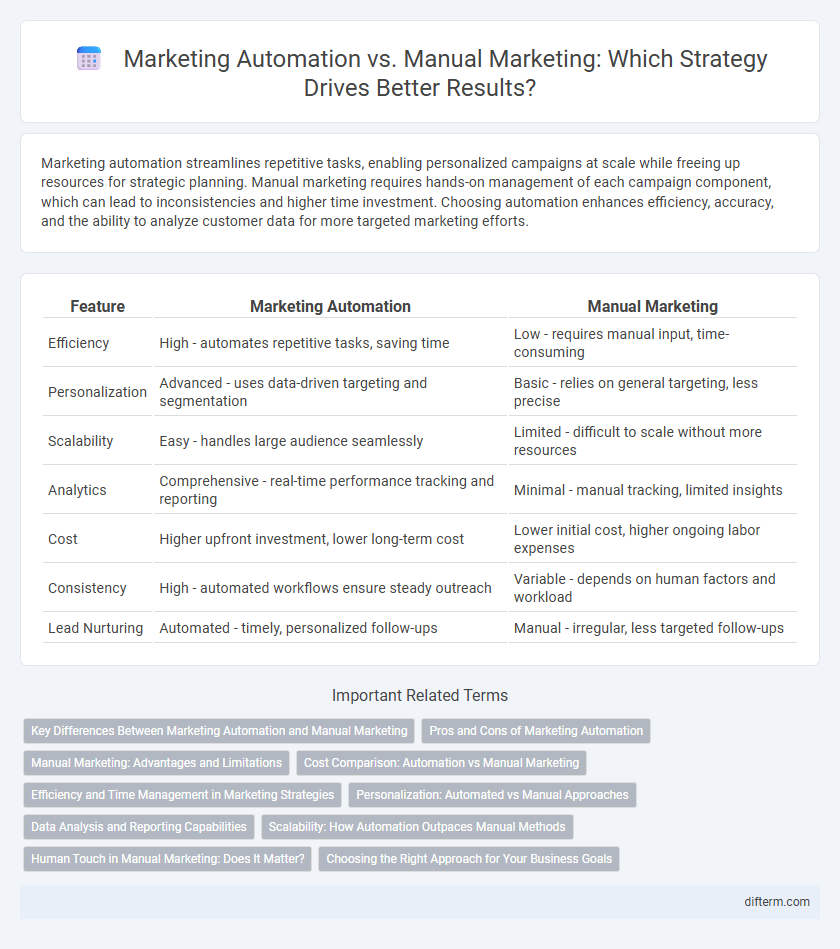Marketing automation streamlines repetitive tasks, enabling personalized campaigns at scale while freeing up resources for strategic planning. Manual marketing requires hands-on management of each campaign component, which can lead to inconsistencies and higher time investment. Choosing automation enhances efficiency, accuracy, and the ability to analyze customer data for more targeted marketing efforts.
Table of Comparison
| Feature | Marketing Automation | Manual Marketing |
|---|---|---|
| Efficiency | High - automates repetitive tasks, saving time | Low - requires manual input, time-consuming |
| Personalization | Advanced - uses data-driven targeting and segmentation | Basic - relies on general targeting, less precise |
| Scalability | Easy - handles large audience seamlessly | Limited - difficult to scale without more resources |
| Analytics | Comprehensive - real-time performance tracking and reporting | Minimal - manual tracking, limited insights |
| Cost | Higher upfront investment, lower long-term cost | Lower initial cost, higher ongoing labor expenses |
| Consistency | High - automated workflows ensure steady outreach | Variable - depends on human factors and workload |
| Lead Nurturing | Automated - timely, personalized follow-ups | Manual - irregular, less targeted follow-ups |
Key Differences Between Marketing Automation and Manual Marketing
Marketing automation leverages software to streamline repetitive tasks such as email campaigns, social media posting, and lead nurturing, increasing efficiency and scalability. Manual marketing relies on human effort for personalized outreach and creative decision-making but is time-consuming and prone to inconsistencies. Key differences include automation's ability to deliver data-driven insights and real-time analytics versus manual marketing's flexibility and nuanced human touch.
Pros and Cons of Marketing Automation
Marketing automation streamlines campaign management by enabling personalized content delivery at scale, significantly improving lead nurturing and conversion rates. However, its high initial setup cost and complexity can be a barrier for small businesses lacking technical expertise. Manual marketing allows for greater flexibility and creative control but is time-consuming and prone to inconsistent messaging, limiting efficiency and scalability compared to automated solutions.
Manual Marketing: Advantages and Limitations
Manual marketing offers personalized customer interactions and greater control over campaign nuances, enabling tailored messaging that resonates deeply with specific audiences. It allows marketers to adapt quickly to immediate feedback without relying on pre-set automation algorithms, ensuring flexibility in dynamic market conditions. However, manual marketing demands significant time and resources, often limiting scalability and consistent execution compared to automated solutions.
Cost Comparison: Automation vs Manual Marketing
Marketing automation significantly reduces labor costs by streamlining repetitive tasks such as email campaigns, social media scheduling, and lead nurturing, resulting in higher efficiency and scalability compared to manual marketing efforts. Manual marketing demands substantial time investment and human resources, leading to higher overheads and potential errors that increase overall expenses. Businesses adopting marketing automation typically experience lower cost-per-acquisition (CPA) and improved return on investment (ROI) due to optimized workflows and data-driven decision-making.
Efficiency and Time Management in Marketing Strategies
Marketing automation significantly enhances efficiency by streamlining repetitive tasks such as email campaigns, social media scheduling, and lead nurturing, allowing teams to focus on strategic planning. Automated workflows reduce human error and speed up campaign execution, resulting in faster turnaround times compared to manual marketing efforts. Data-driven automation platforms optimize time management by delivering personalized content at scale, boosting ROI and campaign effectiveness without increasing resource allocation.
Personalization: Automated vs Manual Approaches
Marketing automation enables hyper-personalization through data-driven insights and real-time customer interactions, surpassing the limitations of manual marketing efforts. Automated systems analyze vast datasets to deliver tailored content, optimizing engagement and conversion rates more efficiently than manual segmentation. Although manual marketing allows for nuanced human judgment, it often lacks the scalability and precision inherent in automated personalization strategies.
Data Analysis and Reporting Capabilities
Marketing automation significantly enhances data analysis and reporting capabilities by providing real-time insights through integrated dashboards and advanced analytics tools. Manual marketing often struggles with data fragmentation and delayed reporting, limiting timely decision-making and strategic adjustments. Automation allows marketers to track campaign performance accurately, segment audiences effectively, and optimize ROI based on comprehensive data-driven reports.
Scalability: How Automation Outpaces Manual Methods
Marketing automation significantly enhances scalability by streamlining repetitive tasks and managing large volumes of data in real-time, enabling campaigns to expand without proportional increases in resources. Manual marketing, constrained by human capacity and time, often struggles to maintain efficiency and consistency as campaign complexity grows. Automated systems leverage AI and machine learning algorithms to optimize targeting and personalization at scale, outperforming manual methods in both speed and adaptability.
Human Touch in Manual Marketing: Does It Matter?
Manual marketing preserves the essential human touch by enabling personalized interactions and authentic customer engagement, which automation often lacks. This personal connection can significantly boost brand loyalty and customer satisfaction, driving higher conversion rates. While marketing automation streamlines processes and scales campaigns efficiently, the nuanced emotional intelligence of manual marketing remains critical in building trust and long-term relationships.
Choosing the Right Approach for Your Business Goals
Marketing automation streamlines repetitive tasks by leveraging software to target and nurture leads efficiently, while manual marketing allows for personalized interactions tailored to unique customer segments. Businesses aiming for scalability and data-driven insights benefit from automation platforms like HubSpot or Marketo, whereas companies prioritizing direct customer engagement or niche markets may find manual strategies more effective. Selecting the right marketing approach depends on factors such as budget, target audience size, campaign complexity, and long-term growth objectives.
marketing automation vs manual marketing Infographic

 difterm.com
difterm.com